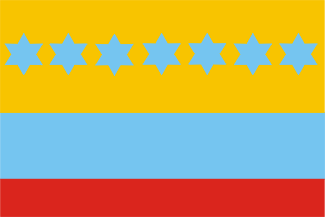
image by Jaume Ollé, 4 October 2001
Flag prescribed on 17 May 1817 in Pampelar by the authorities emanating from the Canaco Congress

Last modified: 2024-07-13 by daniel rentería
Keywords: venezuela | miranda |
Links: FOTW homepage |
search |
disclaimer and copyright |
write us |
mirrors
See:
See Also
Other Sites:
Adopted: 12 May 1817. Abolished: 20 November 1817

image by Jaume Ollé, 4 October 2001
Flag prescribed on 17 May 1817 in Pampelar by the authorities
emanating from the Canaco Congress
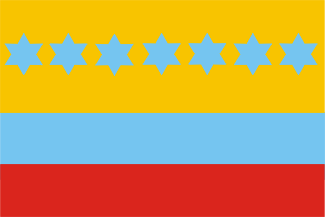
image by Jaume Ollé, 4 October 2001
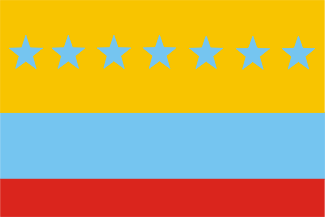
image by Jaume Ollé, 4 October 2001
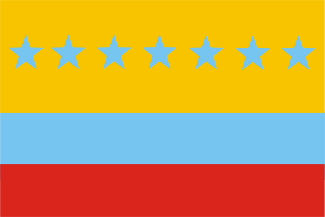
image by Jaume Ollé, 4 October 2001
Adopted: 20 November 1817. Abolished: 17 December 1819

image by Jaume Ollé, 4 October 2001
Flag of Venezuela prescribed on 28 November 1817 in Angostura by the
Chief Supreme of the Republic, Captain General of the Armies of
Venezuela and New Grenada, Simón Bolívar

image by Jaume Ollé, 4 October 2001
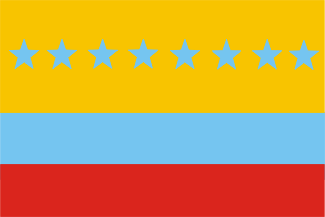
image by Jaume Ollé, 4 October 2001
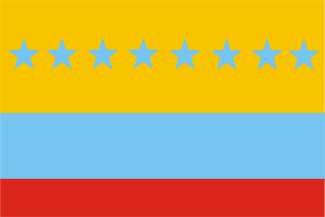
image by Jaume Ollé, 4 October 2001
In 1817, the "coat of arms" is
removed and seven blue stars (representing Venezuela’s 7
provinces) are added to the yellow band.
Jorge V. Alonso-Iglesias
The flag hoisted from 1817 to 1830, was Bolivar's design
(decreed by the Federal Government of Angostura [currently Ciudad
Bolivar], November 20th, 1817), a variation of the one
designed by the Federal Government of Pampatar on the 12th of May
of the same year. This Federal Governemnt of Pampatar included,
for the first time, the seven stars (representing the spanish
colonial provinces which declared its independance in 1810:
Caracas, Cuamana, Barinas, Barcelona, Margarita, Merida y
Trujillo; Coro, Guayana and Maracaibo remained loyal to the
Regent Junta of Cadiz), which were then blue, on the yellow
stripe. PampatarÂ's government was the result of the Cariaco
Congresillo, whcih was not representative of the whole of the
revolutionary effort. In any case, Simon Bolivar, capturing
Angostura and thus freeing Guayana, issued a modified flag, with
eight blue stars on the yellow stripe.
The blue stars were discarded in 1821, when we joined the Great
Colombia, until they were rescued in 1859 by the Federalist
fighters (with seven and later 20 stars). Bolivar's eigth star
never appeared back.
Guillermo Aveledo , 8 september 1999
ISTR that at this time, the stars where blue and placed on the
yellow field... if this is correct, then we are talking about two
different designs
Jorge Candeias , 24 September 1999
Naval Ensign - May of 1817 - The Provisional Congress
establishes on Pampatar (locality of the Margarita Island in the
East of Venezuela) decreed that for use of the Navy will add
seven blue stars to the yellow stripe of the Flag of the
Liberator Army for remember the Provinces that founded Venezuela
on 1811.
Flag decreed by Bolivar - October of 1817 - Angostura, city to
the Southeastern of Venezuela, was captured by the Patriotic
Forces and for register it annexation to the Cause of
Independence El Libertador decrees that the Naval Ensign recently
established in Pampatar will shows in successive eight blue
stars.
Raul Orta, 4 April 2002
See: Great Colombia Federate Republic
Great Colombia Federal Republic, 1819-1821: it refers by Mr.
Daniel Chalbaud Lange in his "Historical Evolution of the
National Flag of Venezuela", General (VAF) Gustavo Machado
Guzman in his "Graphical History of the Independence of
Venezuela" and by Mr. Jaume Olle in this site site . It
combines the flag of Venezuela and the Coat of Arms of New
Granada, as it disposed the Congress of 1819 but the location of
the Coat of Arms and its enamels seem to be a particular
representation in comparison with traditionally reviews of the
Venezuelan Historical Vexillology.
Raul Orta, 6 June 2002
See: Great Colombia Federate Republic
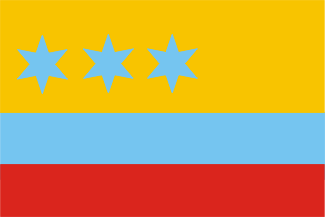
image by Jaume Ollé, 4 October 2001
Flag of the Republic of Colombia (Gran Colombia) prescribed on 12
July 1821 by the Constituent Congress

image by Jaume Ollé, 4 October 2001
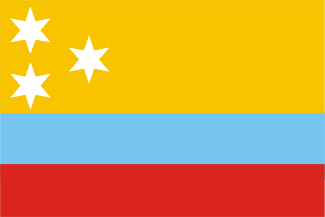
image by Jaume Ollé, 4 October 2001
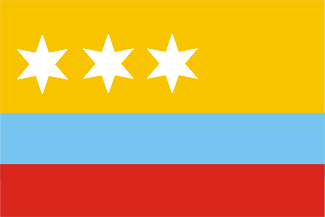
image by Jaume Ollé, 4 October 2001
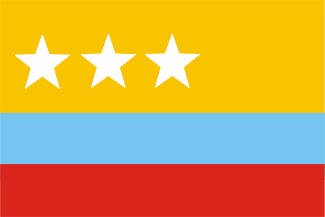
image by Jaume Ollé, 4 October 2001

image by Jaume Ollé, 4 October 2001
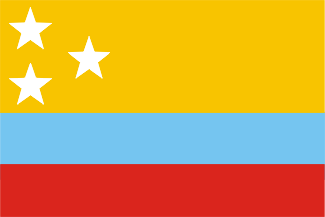
image by Jaume Ollé, 4 October 2001

image by Jaume Ollé, 4 October 2001
The official Coat of Arms of the Republic of Great Colombia
first apparition is dated 6 Octuber 1821 in Cundinamarca and was
in use until 9 May 1834 (same time several variants of the arms
exist). These arms were added to the national flag , but in
Venezuela seems that the information of the exact design of new
arms were sended a bit later and while were used three
stars. Three stars in venezuela (unofficial) were reported in
several patterns. I have the doubt if the three stars symbolized
the three members of Great Colombia (Cundinamarca, Venezuela and
Ecuador) or the three departmente that was divised Venezuela on 2
Octuber 1821 (Zulia, Orinoco and Venezuela) Main source from this
infos is Prof. Restrepo Uribe
Jaume Ollé , 30 September 1999
Lucien Philippe mentions flags with stars for Great Colombia
Federate Republic. Restrepo don't believe that those are
Colombian New-Granadian but Colombian Venezuelan. The sure fact
is that in on 12 May 1817 the governmente called "Federal
Pampatar government" was established in Venezuela that
adopted the Miranda's flag with seven light blue stars. In 20
November 1817 a eighth star was added meaning Guayana. Philippe
reports this flags as used in Colombia c. 1820, but this is
probably a missinterpretation. Philippe even reports a flag with
9 stars it but must be a wrong hand made flag or a mistake. With
three stars the models are well known. There are many variants
and those were used probably between 1819 and 1921, only on flags
with stripes 2:1:1.
Jaume Ollé, 4 October 2001
At J.W Norie - J.S. Hobbs: Flaggen aller seefahrenden
Nationen, 1971[ nor71] (original
print 1848):
276 Colombia - Yellow over blue over white 2:1:1, with in the
yellow in the hoist three five-pointed blue stars pointing down,
placed 2 before 1. If the last stripe is supposed to be red, this
looks like a Great Columbian flag, with the stars directly on the
flag, instead of in arms on the flag.
Peter Hans van den Muijzenberg, 12 November 2001
Provisional Flag of the Gran Colombia - 1821 - Decreed by the
General Congress of Cucuta, combine the Venezuelan Flag and the
CoA of the Republic of Nueva Granada (current Republic of
Colombia)
Flag of the Great Colombia - 1822 / 1830 - Established just a
short time after the previous one, replace the Coat of Arms of
Nueva Granada by the one of the Gran Colombia. See: Great Colombia Federate Republic
Raul Orta, 4 April 2002
Great Colombia Federal Republic, 1822(?): is refers by Mr.
Jaume Olle. Instead of the Coat of Arms, it bears three blue
stars on the yellow stripe, whose probable antecedent is the Flag
decreed in Pampatar for use of Navy on 1817. Some illustrations
of the time exist with the representation of this design. The
flag with white stars could be assumed like artistic
interpretation or color decline of which precedes it.There is a
variation of the previous one in which the stars are arranged
triangular instead of horizontally and consequently, can consider
it an artistic interpretation.
Raul Orta, 7 June 2002
William Crampton is mentioning on page 45 of "Die Welt
der Flaggen und die Wappen aller Länder", Augsburg 1991
(original title: "World of Flags", London):
"The flag of Colombia is based on the flag of Francisco
Miranda, who tried to liberate New Granada in 1806. This
horizontal tricolor-flag in the colors yellow-blue-red was
hoisted in Bogoto in 1813 and was adopted by Great Colombia in
1819. The yellow stripe became double breadth, to create a big
canton, that should show an allegorical image to present the
self-consciousness of the young republic. During 1822 and 1830
the canton contained three blue stars, symbolizing the three
states of the federation (nowadays Colombia, Venezuela and
Ecuador)."
The flag described above, was however not depicted in that book.
J.W. Norie and J.S. Hobbs published in 1848 in London the booklet
: "306 Illustrations of the maritime flags of all
nations". This booklet was revised and reprinted by Rudolf
Hoffmann in 1987 in Hamburg as "Flaggen aller seefahrenden
Nationen". It was completed by translations and some
explanations in German. The publisher claimed however, that he
did not change any flag according to the original booklet.
Hoffmann also mentioned some mistakes in the original booklet. On
page nr. XXII nr.276 Norie and Hobbs showed the image of a flag
of Colombia. It was a horizontal tricolor, the upper half was
yellow, the lower half was a celestial blue over white. In
the upper hoist there were three 5-pointed blue stars in a
triangular configuration. It may be the picture of the flag of
Great Colombia, used between 1822 and 1830.
There remain however two contradictions. There was no white
stripe in the flag of Miranda. There must have been a red one
instead, but Hoffmann did not mention it. The booklet of Norie
and Hobbs was published in 1848. The flag, containing three stars
was, according to Crampton, no longer used in 1848.
Volker PREUß depicted on his web site <www.flaggenlexikon.de>
another version of that Miranda flag. The stars in the upper
hoist are in a horizontal configuration. The colour of the blue
strip according to navy blue in that version. Unfortunately there
is no source given by Mr. PREUß.
Klaus-Michael Schneider, 15 April 2005
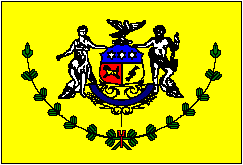
image by Raul Orta, 15 May 2002
Great Colombia Flag, (1821): This project was product of the
Neogrenadinian (Colombian) patriot Francisco Antonio Zea and
consists of a proposal of Shield of Arms surrounded by a garland
of natural laurels on a yellow field. The illustration is a
representation of the original one that still is conserved in the
Bolivarian Museum of Caracas.
Raul Orta, 15 May 2002
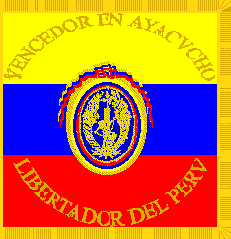
image by Guillermo Aveledo and Raul Orta, 15
May 2002
Standard of the Battalion "Vencedor en Ayacucho",
(1824): This standard, granted to a elite corps of patriotic
soldiers which participated in the Battle of Ayacucho (December
9th, 1824) consists of a quadrilateral and horizontal tricolor
yellow, blue and red that bears the Coat of Arms of Great
Colombia Federal Republic on the center of the blue stripe,
complementing with the inscriptions 'VENCEDOR IN AYACVCHO"
(Victorious in Ayacucho) above and below "LIBERTADOR DEL
PERV" (Liberator of Peru) disposed on circumference arcs
embroidered on golden capital roman letters. The illustration
corresponds to a representation of the original one made by the
Venezuelan Vexillologist Guillermo Aveledo and that at
the moment is exhibited in the Bolivarian Museum of Caracas.
Raul Orta, 15 May 2002
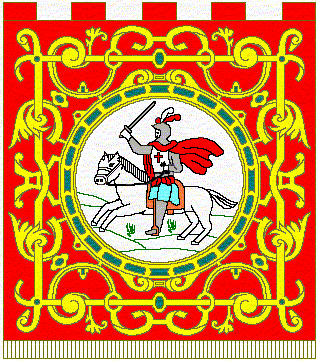
image by Raul Orta, 15 May 2002
Standard of Francisco Pizarro, (1826): This unique piece whose
origin dates presumably from 1533 belonged to the Conqueror
Francisco Pizarro and remained in the Church of Cuzco until
Antonio Jose de Sucre received it and as well he gave it to Simon
Bolivar who donated it finally to the Municipality of Caracas in
1826. At the moment, the original standard and a reproduction are
exhibited on Caracas Museum of the Libertador Municipality Mayor
Office. The graphic is a reconstruction of the obverse: a red
field in whose center appears a medallion rich ornamented with
yellow and green arabesques with the image of Saint James (Called
Santiago in Spanish), Saint Sponsor of Spain. The reverse is
similar to the obverse but it bear the Coat of Arms of Castile
and Leon instead of the Saint James. The Standard also has
smugglers above for the fixation to means of subjection and a
golden fringe below.
Raul Orta, 15 May 2002